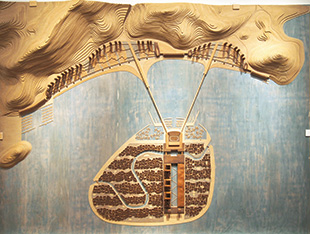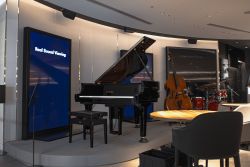
Originally published on metropolis.co.jp on January 2014

Tokyo has something of a reputation for buildings that look like they belong on another planet, but the cutting-edge architecture you sometimes see around you is nothing compared to some of the schemes that have routinely been dreamed up by some of Japan’s top architects over the past several decades.
One of the most avant-garde minds in Japanese architecture is Arata Isozaki, the subject of an exhibition at NTT’s InterCommunication Centre. Isozaki is probably more famous for his theoretical writing such as his classic book, The Japan-ness in Architecture, and conceptualizations of buildings and cities than for actual constructions. Although, over a long career he has also managed to produce an impressive list of avant-garde structures, from the Tsukuba Center Building (1983) to the Qatar National Convention Center (2011), not to mention his biggest project—and possibly his swansong—Zhengdong New District, a vast ring of skyscrapers designed to serve as a major business centre in China.
The show’s title, “Arata Isozaki City Solaris,” is a reference to the famous 1973 Soviet science fiction film Solaris by the Russian director Andrei Tarkovsky, which some critics saw as a response to Stanley Kubrick’s sci-fi classic, 2001: A Space Odyssy. In the movie, a semi-intelligent planet was able to create various scenarios by accessing the minds and memories of the occupants in an orbiting space station. This ties in to Isozaki’s idea that the Earth isn’t a neutral space for building on but more like a spaceship we occupy as we travel through the universe.
Because of Isozaki’s expansive concepts and aura of Blade Runner-esque futurism, there are few more suitable venues for the exhibition than the ICC, a site that specializes in the futuristic, both with a permanent display frequently updated with new works as well as special, temporary exhibitions like the Arata show.
Using architectural models, designs, concept art and an interactive installation, the exhibition attempts to give visitors some insight into Arata’s architectural philosophy. I recommend first researching him online as the exhibition contains no English explanations, surprising for such an international architect, who has built more outside Japan than inside and whose books and academic works have frequently been translated into English.
This will probably limit the appeal of the exhibition to enthusiasts of futurism and architecture, especially those interested in Japan’s Metabolist movement, of which Isozaki was a key member alongside Kisho Kurokawa, Kiyonori Kikutake and Fumihiko Maki. The show is hardly exhaustive, presenting a cross section of works—some built, some unbuilt—that give an insight into his mind, with one or two surprises, like the fact that he designed the layout of New York’s famous Palladium night club back in the 1980s.
But even if this show isn’t quite all it could be, the ICC nevertheless has plenty to offer visitors in its permanent exhibition, where you’re sure to find something of interest in its technologically-themed exhibits.
Until Mar 2, ¥500. NTT Intercommunication Center. 4F Tokyo Opera City Tower, 3-20-2 Nishi-Shinjuku. www.ntticc.or.jp





